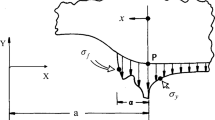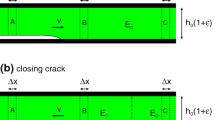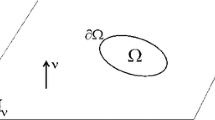Abstract
Equations are developed for predicting crack growth in the opening mode for quite general situations, including many quasi-static and dynamic problems involving moisture and temperature gradients in monolithic and composite materials. Except for the small zone of failing material at the crack tip, the body is assumed to be linearly viscoelastic. A method for obtaining viscoelastic stresses and displacements from elastic solutions is first described. The traction boundary condition for the crack faces is not in general satisfied by these results. However, it is shown by modifying the failure zone in the elastic problem this condition can be met, and an integral equation for the stress in the modified failure zone is derived. Approximate analysis similar to that used previously by the author in stress analysis is then employed to solve the integral equation and develop relatively simple equations for predicting crack speed; these equations relate crack speed in the viscoelastic material to stress intensity factors in a suitably defined elastic body.
Résumé
Des équations ont été développées pour prédire la croissance de la fissure suivant un mode d'ouverture pour des situations tout à fait générales incluant plusieurs problèmes quasi-statiques et dynamiques comportant de l'humidité et des gradients de tempèrature dans des matériaux monolitiques et dans des matériaux composites. A l'exception de la petite zône de matière située à la pointe de la fissure, le corps est supposé être linéairement visco-élastique. Une méthode pour obtenir les contraintes et les déplacements visco-élastiques à partir des équations élastiques est en premier lieu décrite. La condition de frontière à la traction pour les faces de la fissure n'est en général pas satisfaite par ces résultats. Toutefois, on montre qu'en modifiant la zône de rupture dans le problème élastique, cette condition peut être atteinte et une équation intégrale pour la contrainte dans la zône de rupture modifiée est dérivée. Une analyse approximative similaire à celle utilisée précédemment par l'auteur dans l'analyse des tensions est ensuite utilisée pour résoudre l'équation intégrale et développer des équations relativement simples pour prédire la vitesse de fissuration. Ces équations mettent en relation la vitesse de fissuration dans le matériau visco-élastique aux facteurs d'intensité des contraintes dans uns corps élastique défini de manière appropriée.
Similar content being viewed by others
References
R.A. Schapery, “Viscoelastic Behavior and Analysis of Composite Materials”, in Composite Materials, 2 G.P. Sendeckyj Ed., Academic Press (1974) 85–168.
J.C. Halpin, “Introduction to Viscoelasticity”, in Composite Materials Workshop, S.W. Tsai, J.C. Halpin, and N.J. Pagano, Eds., Technomic (1968) 87–152.
R.A. Schapery, International Journal of Fracture, 11 (1975) 141–159.
R.A. Schapery, International Journal of Fracture, 11 (1975) 369–388.
R.A. Schapery, International Journal of Fracture, 11 (1975) 549–562.
G.S. Brockway and R.A. Schapery, “Some Viscoelastic Crack Growth Relations for Orthotropic and Prestrained Media”, Texas A & M University Report No. MM 3064-75-3 (AFOSR Scientific Report No. TR-76-0296) (1975).
R.A. Schapery, “A Theory of Time-Dependent Bonding for Viscoelastic Media”, Texas A & M University Report No. MM 3064-76-4 (AFOSR Scientific Report No. TR-76-1148) (1976).
W.G. Knauss, Applied Mechanics Reviews, 26 (1973) 1–17.
W.G. Knauss, “On the Steady Propagation of a Crack in a Viscoelastic Sheet: Experiments and Analysis”, in Deformation and Fracture of High Polymers, H.H. Kausch, J.A. Hassell, and R.I. Jaffee, Eds., Plenum Press (1974) 501–541.
G.A.C. Graham, Quarterly of Applied Mathematics, 27 (1969) 497–507.
G.A.C. Graham and G.C.W. Sabin, International Journal of Engineering Science, 11 (1973) 123–140.
L.B. Freund, “The Analysis of Elastodynamic Crack Tip Stress Fields”, in Mechanics Today, 3, S. Nemat-Nasser, Ed., Pergamon Press (1976).
Author information
Authors and Affiliations
Additional information
Sponsored by the Air Force Office of Scientific Research, Office of Aerospace Research, grant No. 74-2697. Presented at the “Environmental Degradation of Engineering Materials” conference, October 10–12, 1977. Virginia Polytechnic Institute, Blacksburg, Va.
Rights and permissions
About this article
Cite this article
Schapery, R.A. A method for predicting crack growth in nonhomogeneous viscoelastic media. Int J Fract 14, 293–309 (1978). https://doi.org/10.1007/BF00034690
Received:
Issue Date:
DOI: https://doi.org/10.1007/BF00034690




